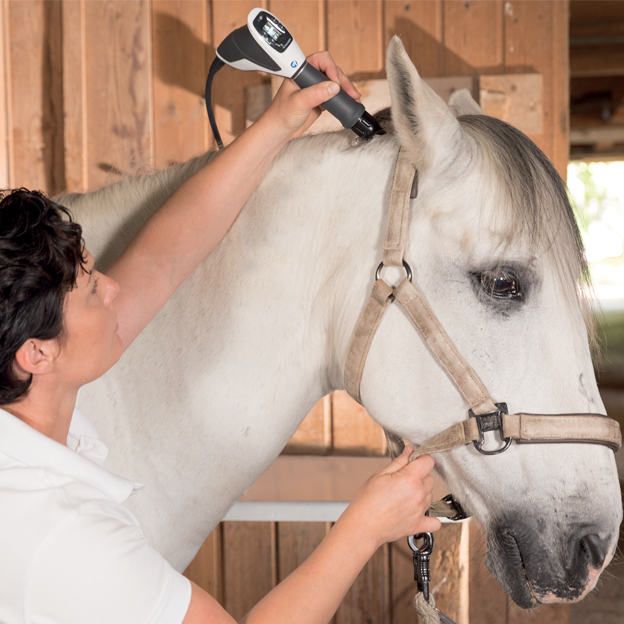Equine Therapy Success Stories: Actual Individuals, Actual Psychological Improvements
Equine Therapy Success Stories: Actual Individuals, Actual Psychological Improvements
Blog Article
How Laser Therapy in Equine Treatment Is Transforming Veterinary Take Care Of Equines
Laser therapy has arised as a transformative technique in equine veterinary care, giving a non-invasive option that accelerates recovery and boosts general wellness. Leveraging specific light wavelengths, this advanced therapy boosts mobile regeneration, decreases swelling, and mitigates discomfort. Its efficacy expands from musculoskeletal injuries to persistent disorders like osteo arthritis, considerably boosting mobility and life high quality for equines. The mobility and flexibility of laser therapy tools further emphasize their expanding indispensability amongst veterinarians. As we discover the detailed auto mechanics and real-world successes, the extensive influence on equine medical practices comes to be progressively obvious.
Understanding Laser Treatment

The innovation behind laser treatment is grounded in the principle of photochemistry, where photons are absorbed by chromophores within cells, resulting in boosted ATP manufacturing and inflection of responsive oxygen varieties (Equine Therapy). This, in turn, promotes cellular proliferation, minimizes swelling, and increases recovery. Vet practitioners utilize different kinds of lasers, consisting of low-level lasers (LLLT) and high-power Course IV lasers, relying on the specific therapeutic objectives and the nature of the equine condition being treated
Various laser wavelengths and power settings are very carefully picked to target various tissue depths and accomplish wanted scientific end results. Security procedures are vital, as incorrect usage can result in thermal damage or suboptimal restorative effects. Thus, a comprehensive understanding of laser therapy's devices and applications is critical for its reliable execution in equine vet technique.
Advantages for Equine Wellness
The myriad advantages of laser therapy for equine health include enhanced recovery, pain decrease, and improved wheelchair. This sophisticated treatment method leverages particular wavelengths of light to penetrate cells, stimulating cellular function and promoting quick tissue repair service. The non-invasive nature of laser therapy makes certain very little stress and anxiety and discomfort for the equine, helping with a smoother recovery procedure.
Boosted healing is one of the primary advantages, as laser treatment speeds up cellular regrowth and collagen synthesis. This causes faster recuperation times from injuries and procedures. Pain reduction is attained through the anti-inflammatory impacts of laser treatment, which lowers swelling and reduces the production of pain-inducing chemicals. As an outcome, steeds experience significant relief from chronic and sharp pain problems.
By reducing swelling and discomfort, and improving tissue repair work, laser therapy aids in recovering joint feature and muscle mass flexibility. Thus, laser treatment stands as a transformative device in contemporary equine veterinary care.
Usual Conditions Treated
Laser therapy has actually arised as a versatile therapy option for a selection of typical equine problems. Furthermore, laser therapy is reliable for conditions like osteo arthritis, where it assists mitigate joint swelling and promote cells fixing.
Wound administration is another area where laser treatment has revealed significant pledge. Chronic injuries or slow-healing abscess can be especially tough in equines, yet laser therapy enhances mobile regeneration and boosts blood circulation, hence expediting the healing procedure. Laser treatments have been efficiently employed in managing unguis conditions such as laminitis and abscesses, easing pain and advertising much faster healing.

Technology Behind Laser Therapy
Beyond the myriad conditions treatable with laser treatment, the modern technology itself merits closer examination. At the heart of laser therapy is making use of particular wavelengths of light to penetrate tissues and generate biological reactions. These wavelengths, normally varying from 600 to 1000 nanometers, are selectively absorbed by chromophores in the skin, muscle, and various other cells, prompting a waterfall of mobile events.
Laser gadgets used in veterinary medication often use low-level laser treatment (LLLT) or cold laser treatment. Unlike high-powered surgical lasers, these tools run at lower power degrees, optimizing restorative benefits while minimizing thermal damages. The power from the laser light boosts adenosine triphosphate (ATP) production, boosts mobile metabolic process, and accelerates tissue fixing processes.

Success Stories and Study

Showcasing the concrete advantages of laser treatment, countless success stories and study illuminate its transformative influence on equine wellness. One such instance includes a thoroughbred racehorse suffering from chronic tendonitis. Standard treatments produced marginal improvement, however after integrating laser therapy into the program, the steed displayed considerable decreases in inflammation and pain within weeks, inevitably going back to competitive racing.
Another engaging example features a dressage steed detected with severe back pain, restricting its performance. A vet group utilized low-level laser treatment (LLLT) to target the irritated locations, leading to marked improvement in flexibility and a remarkable reduction in pain. Over a number of sessions, the equine regained its peak type, showcasing the efficacy of laser therapy in addressing bone and joint problems.
In addition, a research study conducted at a leading equine clinic examined 50 horses with numerous soft cells injuries treated with laser therapy. The outcomes were striking: 85% of the steeds demonstrated visit homepage sped up recovery times and enhanced wheelchair. These instances emphasize the versatility and efficiency of laser treatment in equine medicine, supplying a non-invasive, scientifically-backed technique to improving healing and efficiency in equines.
Verdict
Laser treatment is transforming equine vet care by giving a non-invasive therapy that accelerates healing, decreases swelling, and reduces discomfort. With its effectiveness in treating a variety of problems, from bone and joint injuries to chronic disorders like osteo arthritis, this modern technology substantially improves a knockout post equine wellness and movement. The portability and flexibility of laser therapy better emphasize its transformative influence on veterinary methods, solidifying its function as a crucial tool in modern-day equine health care.
Report this page